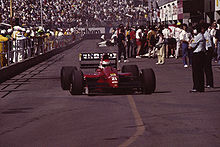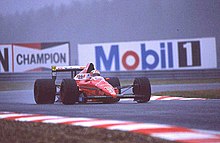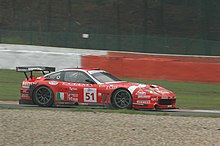BMS Scuderia Italia
| Surname | BMS Scuderia Italia |
|---|---|
| Companies | BMS Scuderia Italia SpA |
| Company headquarters | Brescia , Italy |
| Team boss | Giuseppe Lucchini |
| statistics | |
| First Grand Prix | San Marino 1988 |
| Last Grand Prix | Portugal 1993 |
| Race driven | 92 |
| Constructors' championship | - |
| Drivers World Championship | - |
| Race wins | 0 |
| Pole positions | 0 |
| Fastest laps | 0 |
| Points | 15th |
The Brixia Motorsport Scuderia Italia is an Italian racing team , which by the Italian steel magnate and motorsport enthusiasts Giuseppe Lucchini in Brescia was founded.
In 1987 the team started under the name Brixia Motor Sport in the touring car world championship . After entering Formula 1 in 1988 , it was renamed BMS Scuderia Italia . Since withdrawing from Formula 1 in 1993 , the team has returned to sports car , GT and touring car racing.
formula 1
overview
BMS Scuderia Italia made its debut in the 1988 Formula 1 World Championship. The reason for entering the Grand Prix sport was the imminent end of the so-called turbo era of Formula 1 and the associated expectation that the operation of a Formula 1 team with naturally aspirated engines would be easier to finance again. On this basis, numerous new teams appeared in Formula 1 from 1987, including Coloni and EuroBrun from Italy, AGS and Larrousse from France and Onyx and March from Great Britain. Most of these teams built their own racing cars. Only Larrousse commissioned the British specialist Lola Cars to develop and build his car. Giuseppe Lucchini decided on the concept of Gérard Larrousse when he entered Formula 1 : Lucchini entered into a partnership with the established Italian manufacturer Dallara , which designed and manufactured the racing cars used by BMS. The relationship lasted until 1992 and was closer than the connection between Larrousse and Lola. Giampaolo Dallara was often at the racetracks himself and led the operations. Because of this close connection, the team was also imprecisely referred to in some media as Dallara or BMS-Dallara. After the unsuccessful 1992 season, Lucchini changed manufacturers for the following year: In 1993, the BMS cars were built by Eric Broadley's company Lola Cars, which had meanwhile broken the connection with Larrousse. After no increase in success could be achieved through this change either, BMS gave up its own Formula 1 commitment at the end of the 1993 season. Instead, Lucchini participated in the Italian team Minardi in 1994 and 1995, which was reported as Minardi Scuderia Italia at that time.
1988
In its first Formula 1 season, BMS Scuderia Italia started with just one driver. The regular pilot was the Italian Alex Caffi , whose work at Osella was financially supported by Lucchini in 1987. By registering for the Formula 1 World Championship in 1988, BMS had committed to compete in each of the 16 races of the season; skipping a race would have excluded the team from the entire season. However, Dallara was behind schedule with the development and construction of the Formula 1 car in the winter months, so that the new car was not ready for the first race in Brazil .
In order to meet the obligation to participate, Scuderia Italia in Brazil reported the Dallara 3087 , a Formula 3000 car that Dallara had designed for the 1987 Formula 3000 season . It was still equipped with the 3.0 liter DFV eight-cylinder engine in accordance with the Formula 3000 regulations, although the Formula 1 regulations had allowed naturally aspirated engines with 3.5 liters displacement since 1987. He also had the rev limiter prescribed for Formula 3000 , which automatically shut down the engine at 9,000 revolutions per minute. The 3087 was clearly underpowered. Caffi was eliminated with him in the pre-qualification. His fastest lap time was 11 seconds over the time of the last qualified driver Gabriele Tarquini (Coloni) and 18 seconds over the later pole time of Ayrton Senna ( McLaren ).
For the 1988 San Marino Grand Prix, the second race of the season, the Dallara F188 appeared , which was designed directly for Formula 1. Dallara built three copies of the car during the season. The F188 was powered by a 3.5 liter eight-cylinder Cosworth DFZ engine. It was one of the weakest engines in the field. With him, Caffi was able to qualify for 14 out of 15 world championship races, only in Canada he failed at the pre-qualification. He failed seven times and finished seven times. However, there was no arrival in the points this year.
1989
The Formula 1 1989 season had 20 teams and 39 cars, the largest starting field for decades. In order to keep the actual qualification practicable, a pre-qualification was carried out on Friday morning before the first training session, in which the six weakest teams from the previous year competed against each other; only the four fastest were allowed to participate in the subsequent timed practice. The Scuderia Italia, which had not scored any World Championship points in 1988, was one of the teams in the first half of the 1989 season that had to pre-qualify. The team competed with two drivers this year. Alex Caffi, who remained in the team, was complemented by Andrea de Cesaris , whose commitment led to an increase in sponsorship funds from Marlboro Italia . The emergency vehicle was the Dallara Bms 189 designed by Giampaolo Dallara and Marco Tollentino , which in turn was powered by a Cosworth eight-cylinder engine. The engine was tuned by Heini Mader Racing Components in Switzerland.
The team's second season was successful. With two exceptions (Caffi in Brazil and Great Britain ), the BMS pilots regularly achieved the pre-qualification and then almost always the qualification. By reaching the finish line in fourth place in Monaco, Caffi earned the first world championship points for his team, which were supplemented by another point in Canada . De Cesaris finished third in Canada, the first of a total of two podium positions for the team. Because of the good results in the first half of the season, Scuderia Italia was exempt from pre-qualification from the German Grand Prix . However, neither Caffi nor de Cesaris achieved another finish in the points in the second half of the season. With a total of eight world championship points, Dallara finished eighth in the constructors' championship at the end of the year.
1990
In the 1990 season, Scuderia Italia fell far short of expectations. The Dallara F190 was a "poor", unreliable car whose upgraded Cosworth DFR engine did not develop enough power to enable the team to catch up with the leaders. Andrea de Cesaris remained in the team as a top driver. For the second cockpit, Scuderia Italia signed Emanuele Pirro , who, however, was unable to take part in the first two races due to illness, so Ferrari's test pilot Gianni Morbidelli was reported twice in his place . De Cesaris only crossed the finish line twice, Pirro three times during the entire season. Both finished in tenth place each (de Cesaris in Belgium and Pirro in Hungary ). Those were the team's best results this year.
1991
For the 1991 season, Scuderia Italia changed the engine supplier. The team exclusively used a newly designed ten-cylinder V-engine from Engine Developments , known as the Judd GV , for the Dallara F191 . With an output of initially 660 and later 700 hp, it was much more powerful than the Cosworth engines previously used. The gearbox and the rear axle were designed by Dallara itself. In addition to Emanuele Pirro, JJ Lehto was the first time a non-Italian racing driver drove for the team.
Because of the poor results in the previous year, Scuderia Italia was subject to the pre-qualification again in the first half of the season. Pirro failed three times in the pre-qualification ( San Marino , Mexico and France ) and only crossed the finish line once in the entire year when he finished sixth in Monaco . Lehto got along a little better with the F191; the pre-qualification wasn't a problem for him. He finished his third race in San Marino with a podium in third place. Because of this result, Scuderia Italia was again exempt from pre-qualification for the second half of the season. In addition, however, Lehto only managed three more finishings, each of which was outside of the points. In the end, Dallara finished eighth in the constructors' championship with five points. After the end of the season, Dallara sold the rear axle construction and the gearbox to the Andrea Moda Formula team , which initially installed the parts in an old Coloni C4 , which was unsuccessfully registered as the Coloni C4B in 1992 . The parts were later reused for the Andrea Moda S921 .
1992
In the 1992 season, Dallara competed for the first time with twelve-cylinder engines from Ferrari , which corresponded to the status of the unit used in the Ferrari models 642 and 643 in 1991 . The vehicle used, the Dallara BMS192 , largely corresponded to the previous year's model, which was only adapted to the new engine type and its increased fuel consumption compared to the previous Judd engine. JJ Lehto stayed with the team as a driver, while Emanuele Pirro moved his racing career to various touring car series. Lehto's new team-mate was Pierluigi Martini , for whom the year at BMS Scuderia Italia should be the only full season of his long career that he played with a team other than Minardi .
The season turned out to be sobering again. The engine did not harmonize with the barely redesigned chassis, so the drivers complained about difficult handling. Martini scored the only points of the year with sixth place each in the races in Spain and San Marino . Lehto's best result was a seventh place in Belgium ; otherwise the Finn proved to be a reliable driver and only dropped out four times in a total of 15 races. In Hungary, however, Lehto was responsible for the team's only non-qualification in the whole year.
1993
For the failures of the 1992 season, Giuseppe Lucchini ultimately sought responsibility at Dallara and therefore decided to commission the chassis for the 1993 season from Lola in Great Britain instead . The vehicle designed by Eric Broadley was called the Lola T93 / 30 and was again powered by a Ferrari twelve-cylinder, this time the Tipo 040 model , which had powered the F92A, which was disappointing due to problematic aerodynamics, was used in the previous season. The driver pairing has been completely reorganized: Luca Badoer made his debut alongside the Italian veteran and former Grand Prix winner Michele Alboreto , who came from Footwork .
However, the season was disappointing overall. In fourteen races, Alboreto or Badoer together failed to qualify seven times. Together, both drivers also recorded a total of thirteen cancellations. If at all, there were mostly finishings in the back of the field and several laps behind the race winner. Only the technically similar problematic vehicles from Tyrrell and Footwork could occasionally be beaten on the track. Badoer's best result of the year with seventh place at the San Marino Grand Prix was emblematic : Badoer was three laps behind race winner Alain Prost and was lapped by Fabrizio Barbazza's Minardi, who was ahead of him . Behind Badoer, only Aguri Suzuki finished seven laps behind, while all the other drivers were either better or had previously retired.
The decisive factor for these inadequate results was the extremely conventionally designed chassis of the T93 / 30, which suffered from weight problems, was difficult to set up, did not use driving aids such as traction control or an active chassis and was difficult to control. As there was no improvement in sight, BMS Scuderia Italia no longer competed in the last two overseas races of the season. Instead, Lucchini announced that it would merge its racing team with Minardi, which started under the name Minardi Scuderia Italia in the following season in 1994 . After this season, Lucchini withdrew completely from Formula 1 in order to concentrate on touring car racing instead.
Balance sheet and statistics
In six years the team scored 15 world championship points. The most successful years were 1989 and 1991 , when Scuderia Italia scored eight (1989) and five world championship points respectively and was eighth in the constructors' championship with chassis partner Dallara. At the Canadian Grand Prix in 1989 reached Andrea De Cesaris with the third stop place the best individual result for the Italian team, JJ Lehto at the Grand Prix of San Marino in 1991 repeated. Alex Caffi (sixth in Canada 1989 and fourth in Monaco 1989 ), Emanuele Pirro (sixth in Monaco 1991 ) and Pierluigi Martini (1992, two sixth places in Spain and San Marino ) reached further positions in the points scoring .
| season | Team name | chassis | engine | tires | Points | World Cup rank |
|---|---|---|---|---|---|---|
| 1988 | BMS Scuderia Italia |
Dallara 3087 dallara 188 |
Ford Cosworth DFV 3.0 V8 Ford Cosworth DFZ 3.5 V8 |
G | 0 | 12. |
| 1989 | BMS Scuderia Italia | Dallara bms 189 | Ford Cosworth DFR 3.5 V8 | P | 8th | 8th. |
| 1990 | BMS Scuderia Italia | Dallara F190 | Ford Cosworth DFR 3.5 V8 | P | 0 | 15th |
| 1991 | Scuderia Italia SpA | Dallara 191 | Judd 3.5 V10 | P | 5 | 8th. |
| 1992 | Scuderia Italia SpA | Dallara BMS192 | Ferrari 3.5 V12 | G | 2 | 10. |
| 1993 | Lola BMS Scuderia Italia | Lola T93 / 30 | Ferrari 3.5 V12 | G | 0 | 12. |
Touring car racing
Following Formula 1, the team switched back to touring car racing. The newly founded Super Touring Car Cup was chosen in 1994 . The team ran two Nissan Primeras from 1994 to 1996 in this series. The team then withdrew from the sport, briefly returning to the Italian touring car championship in 1998 to put two Type 155 vehicles to the start with Alfa Romeo .
Sports car sport
Between the touring car engagements in the German and Italian championships, team owner Lucchini was one of the first customer teams to receive a Porsche 911 GT1 and entered the vehicle in the 1997 FIA GT championship . Then BMS switched to prototype racing to register a Ferrari 333SP in the FIA sports car championship . This vehicle was used by the team from 1999 to 2001. After that, the team returned to the FIA GT Championship and relied on one of the Ferrari 550 GTS Maranello developed by Prodrive . The team won the championship title twice until 2004 and then tried the same vehicle in the Le Mans Endurance Series . BMS also won the GT1 category there in the 2005 season .
Due to the success with the Prodrive vehicle, BMS was also given the opportunity in 2006 to use Prodrive's latest GT1 development, the Aston Martin DBR9 . In addition, the team returned to the FIA GT Championship as Aston Martin Racing BMS . In addition, the team also fielded two Aston Martin DBRS9s under the name Brixia Racing in the near-series FIA GT3 European Championship and the Italian GT Championship. In 2007, team owner Lucchini expanded his involvement in the FIA GT championship and also launched a Porsche 997 GT3 RSR with the support of Porsche factory driver Emmanuel Collard . In 2008 and 2009 the team switched completely to the GT2 category of the series, but now reported two Ferrari F430s . In 2010 the team with driver Romain Dumas in a Porsche won the 24-hour race at Spa-Francorchamps and thus the FIA GT2 European Cup.






